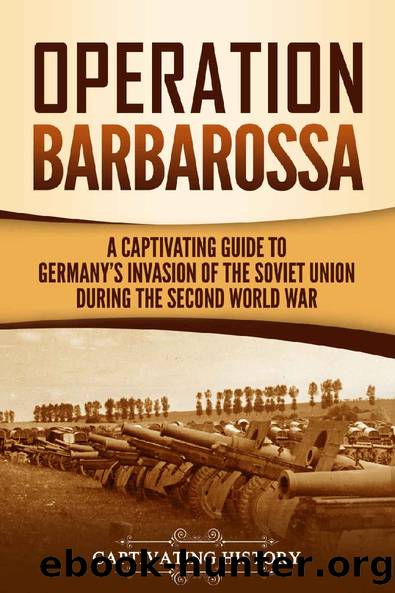Operation Barbarossa: A Captivating Guide to the Opening Months of the War between Hitler and the Soviet Union in 1941â45 by Captivating History

Author:Captivating History [History, Captivating]
Language: eng
Format: epub
Published: 2020-06-08T00:00:00+00:00
When the Germans invaded the USSR in June 1941, they did so with an estimated 6,000 armored vehicles. The bulk of the German tanks were Panzer Mark Is and IIs, both of which were obsolete even before the war began in Poland in 1939. The Mark I was more of a turreted armored car than a tank, though it had treads. Its armor was thin and riveted, and it was armed with only two 7.92 mm machine guns, which were mounted in the turret. It had no cannons whatsoever. The vehicle was good for putting down lightly armed civil insurrections, and that was about it. Its thickest armor was half an inch thick, and that was just in the front. The tank was susceptible to even the smallest caliber anti-tank guns. As the war went on, the thousands of Mark Is were gradually modified; many of them had their turrets removed, and their chassis were able to carry a variety of guns as âtank destroyersâ and mobile artillery.
The Panzer Mark II was a slight improvement. German military observers and intelligence agents in other countries, particularly France, reported that many of the tanks they were seeing were significantly better than the Germans. The Germans began a crash course in building better tanks, but as a stopgap, they constructed the Mark II, which was made by the same factories that made the Mark I. The most significant difference between the two tanks was the 20 mm/2 cm guns the Mark II carried as opposed to the machine guns of the Mark I. The Mark II also had a hull-mounted 7.92 mm machine gun for defense against infantry. The tank could easily be destroyed by most Allied anti-tank guns.
As the Mark Is and IIs were making their way through Poland, German engineers were busy designing an up-to-date tank for the Wehrmacht. This was the Mark III, which became the workhorse of the German Army, going through a number of modifications (mostly increases in armor protection and larger, longer cannon) throughout the conflict. A total of nearly 6,000 Mark III variants were built in 1943, and many of the survivors saw duty in various Eastern European countries after the war.
So, if the German tanks were actually not as good as many of the Allied tanks they faced, particularly at the start of the war, why do we consider the Germans the masters of armored warfare during World War II? Well, war is more than just equipment: itâs also about training, leadership, discipline, and tactics.
But what were the tactics that allowed the Germans to surprise and overwhelm their enemies in the first two years of the war? Broken down to its most basic form, the blitzkrieg consisted of a variety of elements all working together. Firstly, weak points in the enemyâs defenses would be found. Strong points would be avoided, maneuvered around, or simply held in place by a feinting attack. Then, a strong armored column, working in close conjunction with massive concentrated air attacks,
Download
This site does not store any files on its server. We only index and link to content provided by other sites. Please contact the content providers to delete copyright contents if any and email us, we'll remove relevant links or contents immediately.
| Africa | Americas |
| Arctic & Antarctica | Asia |
| Australia & Oceania | Europe |
| Middle East | Russia |
| United States | World |
| Ancient Civilizations | Military |
| Historical Study & Educational Resources |
The Light of Days by Judy Batalion(1063)
First Platoon: A Story of Modern War in the Age of Identity Dominance by Annie Jacobsen(902)
Stalin's War: A New History of World War II by Sean McMeekin(861)
The Pacific War 1941-1943 by James Holland(803)
Walk in My Combat Boots by James Patterson(765)
The American War in Afghanistan by Carter Malkasian(742)
Victory's Price (Star Wars) by Alexander Freed(734)
The Vietnam War: An Intimate History by Geoffrey C. Ward & Ken Burns(721)
Blood and Ruins: The Great Imperial War, 1931-1945 by Richard Overy(686)
Operation Pedestal by Max Hastings(683)
Concepts of Space by Jammer Max;(667)
Cold War (Alexander King Book 2) by Bradley Wright(660)
Extreme Fitness by Chris McNab(654)
The Madman Theory by Jim Sciutto(651)
Flying Tiger by Samson Jack(634)
World War II Infantry Fire Support Tactics by Gordon L. Rottman(612)
Pathfinders by AL-KHALILI JIM(611)
Panzerkrieg by Mike Syron(601)
Hitler’s Pre-Emptive War: The Battle for Norway, 1940 by Henrik O. Lunde(585)
